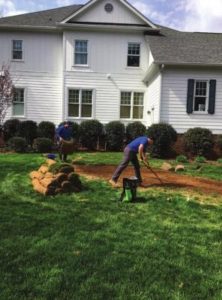
Turf Connections, and the company’s president, Marc Marsh, are featured in the Cover Story of the May 2019 issue of a national landscape magazine, Irrigation & Green Industry News. In the article, Marsh is interviewed for his expertise in how to choose the right turfgrass variety for any landscape project. Marsh was ideally qualified to be quoted in the article because, as a sod producer who grows both warm-season and cool-season grasses, he can address questions about turfgrass used in nearly any part of the United States. Turf Connections grows fescue, bermudagrass and zoysia at farms in North Carolina and South Carolina.
The article titled “Getting in the Green Zone” begins this way:
Marc Marsh’s phone rings as he looks out over acres of deep green zoysia and Bermuda grass growing at his sod farm in Cheraw, South Carolina. On the phone is a local landscape contractor calling to ask Marsh’s advice about which grass variety to plant in a client’s large landscape project. As president of Turf Connections, Marsh operates four such farms in North and South Carolina, and he takes calls like this on a daily basis.
“Where is the job located?” Marsh asks the caller and with good reason.
Grass selection, just as in real estate, boils down to, “location, location, location.” It is the first and most important factor to consider.
Just as palm trees thrive in warmer climates and fir trees love cooler zones, turfgrass species, too, are divided into cool-season and warm-season categories. Once you know which “season” the location you’ll be planting lies in, you’ll be halfway home.

Other than that, the difference between them is that cool-season grasses are predominantly grown from seed, and warm-season grasses are predominantly grown from sprigs. Both cool-season and warm-season grasses are available as sod.
… the story continues …
Turf Connections’ two North Carolina sod farms are in the “transition zone,” the middle region of the country that straddles the dividing line between climate zones, where both cool- and warm-season grasses are planted. At those two farms, Marsh grows tall fescue because that’s what is mainly preferred in Charlotte and the surrounding metropolitan area. In Greenville, South Carolina, less than two hours south of Charlotte, Bermuda and zoysia are preferred.
Planting turf in the transition zone is a bit more complicated. If both cool- and warm-season grasses will work, how do you choose which one to plant? In those cases, Marsh says regional preferences, microclimates or other factors must also come into play.
Irrigation & Green Industry News is the official publication of the Irrigation Association and is distributed to professionals in the irrigation and landscape industries nationwide.
READ THE FULL STORY HERE
Link to story: https://npaper-wehaa.com/igin/2019/05/#?page=14
Copyright 2025 Turf Connections | Privacy Policy